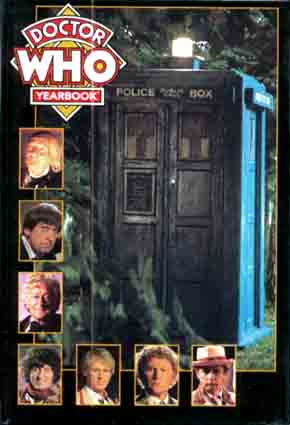The 1996 Yearbook

|
|
Marvel Comics The 1996 Yearbook |

|
| Published | 1995 |  |
| ISBN | 1 85400 377 1 |
| Starring the first seven Doctors, but fictionally only the fourth |
A Review by Finn Clark 13/5/04
This was Marvel's longest Yearbook (96 pages), but I have trouble
imagining anyone reading more than twenty pages of it. It's mostly a
season-by-season breakdown of Doctor Who which is well composed,
well illustrated, contains unfamiliar information and will probably never
be read by anyone ever again. As a reference guide it's obviously
outclassed by the various Howe-Stammers-Walker books, while if I'm merely
looking for something Whoish to read I'll usually turn to fiction.
I couldn't bring myself to read this cover to cover and I'm reviewing the
bloody thing! It's well produced and I suppose the odd fan might use it
for reference from time to time, but frankly I'd be surprised.
In other words, for me this chunky hardback is a 16-page comic with
eighty pages of filler. I suppose some readers will be interested in Mary
Ridge or Hinchcliffe's unused story proposal, but you could pick up
similar articles in any random issue of DWM.
So what did I think of those aforementioned comic strips?
Bravely but interestingly, these are explicit sequels to golden age
comic strips from Tom Baker's Marvel era. Obviously this invites
comparison with better stories... but on the other hand, it could be seen
as an attempt to rise above the mundane level of Yearbook comic strips to
date. DWM's comic strip of 1979-87 was produced by creators from the
world of comic strips rather than Who and in my opinion the results
had more zest and fun than just about everything we've seen since. Many
esteemed Who writers have failed (in my opinion) with their comic
strips in DWM, e.g. Paul Cornell, Gareth Roberts. It's a deceptively
difficult medium to master. Comics aren't just short stories with
pictures, you know.
So is this 1996 experiment in seventies nostalgia successful? In one
of the two stories, yes!
Star Beast II is the one that isn't. Martin Geraghty is no Dave
Gibbons, while Gary Gillatt's script is pretty dull. (However it includes
a fanwank reference to Nightshade: The Motion Picture, which is surprising
from the man who practically led a crusade against the books as editor of
DWM.) Beep the Meep would return again after this story, but always to
better effect.
However Junkyard Demon II is pretty cool. Adrian Salmon might
be the only artist who could have followed Mick McMahon, while Alan Barnes
takes the piss out of Lovejoy in an entertaining comedy. Oh, and Flotsam
and Jetsam get first names reminiscent of Steptoe and Son. These eight
pages of high-impact fun are the reason why I'm glad I paid good money for
the 1996 Yearbook.
Comic strips excepted, this book is a waste of trees. It's well
produced, but mostly pointless. By all means seek out a copy, but only if
you're a completist or a comic strip fan.